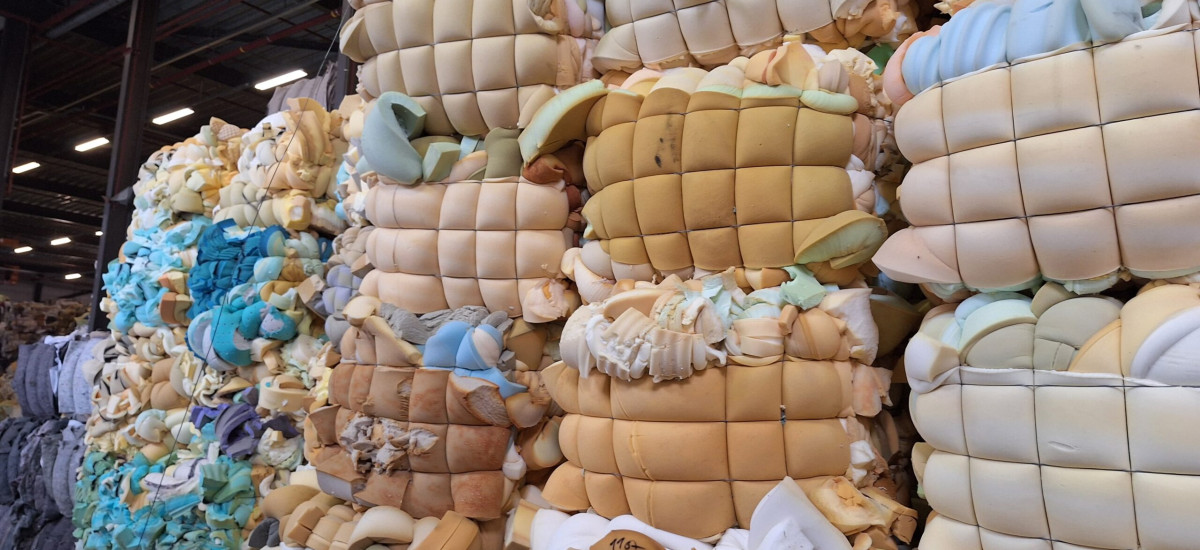19/2/2025
Imagine a warehouse filled to the brim with mountains of compressed mattress materials – foam, springs, and fabric. This is a common sight in recycling companies, where large quantities of discarded mattresses await processing. While recycling is crucial, it also presents fire hazards. Without careful attention to fire safety, a single spark could possibly ignite these flammable materials, leading to possibly devastating consequences.
Matras Recycling Europe, a leading company in mattress recycling, is taking proactive steps to ensure the safety of its employees, the environment, and the community. As part of this commitment, they are conducting a series of fire tests to determine the fire load of their materials and assess the adequacy of their existing sprinkler system. This proactive approach is crucial as the recycling industry grapples with the increasing volume of discarded mattresses and the associated fire risks.
The challenge
Mattresses are a complex mix of materials, including highly flammable foams, combustible fabrics, and metal springs. Matras Recycling Europe (MRE) faces a critical challenge: ensuring that their sprinkler system can effectively suppress a fire in their 8000-square-meter facility. With a large volume of combustible materials stored on-site, the potential for a significant fire is a serious concern for MRE and local authorities. The local fire department has also raised concerns about the risk of fire and the challenges of managing a potential fire.
While the large quantity of mattress materials increases the overall fire load, compressing these materials into dense bales for storage and transport creates a different scenario. The absence of air within the bales might limit the extent of combustion and fire spread. However, further research is needed to determine the exact extent of this effect.
The research
To better understand the fire behavior of these material bales, Efectis Nederland is conducting a comprehensive series of fire tests. The first step is to determine the calorific value of the different materials. This test, standardized by EN ISO 1716, measures the total amount of heat a material releases when it is completely burned. This information is crucial for understanding the potential consequences of a fire, such as burn duration.
Based on the calorific value and the weight of a bale, various fire configurations will be simulated using the Cone Calorimeter test (according to ISO 5660-1) to determine how much energy and smoke the material releases and how much mass is lost over time when exposed to intense heat radiation. This will help predict the behavior of the material in a fire under different conditions. The combination of both test series will determine which test specimens/bales can be considered representative for conducting more extensive tests to determine fire behavior.
To further investigate the material behavior of a bale of material, two bales will be stacked and tested in the Intermediate Scale (NPR 6999). Large-scale tests, such as those conducted in the Intermediate Scale, investigate fire behavior under more severe fire scenarios to assess how quickly a fire can spread through stacks of compressed mattress materials. We will simulate a fire under the bale wall and check if there is fire spread over the bales, while also conducting an energy measurement based on oxygen depletion in the air.
Simultaneously, a test will be conducted in our ad-hoc room where we can observe how fire spread occurs between different bales or through a bale. Based on the tests, it will become clear how quickly the fire spreads and how much material becomes part of the initial fire. The results of these tests will be used by Efectis to, taking into account the sprinkler system in accordance with the sprinkler standard (NFPA 13 and/or EN 12845), make a statement about the amount of material that is expected to become part of an initial fire and the likelihood that such a fire can be controlled or extinguished by the on-site sprinkler system.
The above-mentioned plan was drawn up in consultation with Matras Recycling Europe and then discussed with the competent authority. The competent authority responded positively to the proposed approach and the first test series has started.
The importance of proactive fire safety
For most industries, the activities they are engaged in are not always covered by standard procedures and norms. It is therefore important for them to take the initiative to investigate the risks that arise from the often unique situation within their company. With this research, Matras Recycling Europe is proactively taking responsibility for fire safety, thereby demonstrating their commitment to the well-being of their employees, the environment, and the community.
For more information, please contact Cindy Beckers

